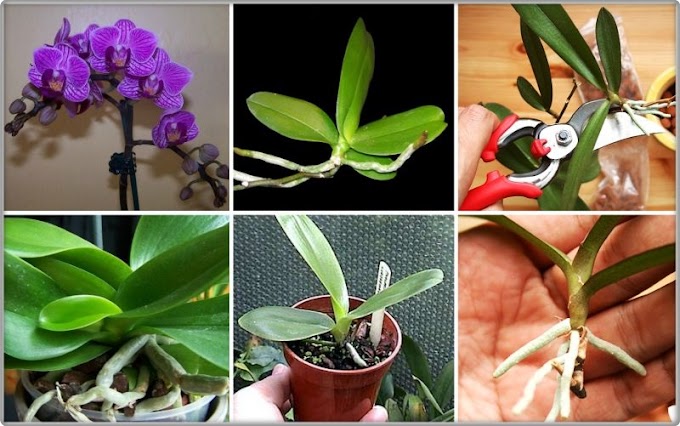Clumping types grow well in flower gardens too, adding nice pink-to-burgundy colored blooms in late summer.
When & Where to Plant Sedum
Light: Sedum (or ‘stone crop flower’) do best in full to part sun. While taller hybrids need full sun to flower their best, creeping types will grow fine in part shade.
Soil: Sedums like a very well-drained soil with a neutral to slightly alkaline pH. Wet, heavy clay can lead to root and stem rot.
Spacing: Space tall growing sedums 1 to 2 feet apart. Space low-growing, creeping sedums 6 to 12 inches apart, depending on the variety and how quickly you want it to fill in an area.
Planting: Plant sedums in spring after danger of frost has passed. In northern areas, you can continue to plant transplants until late summer. In warmer areas, plant in spring or fall.
 |
| source pic: gardeningwithcharlie.com |
How to Grow Sedum Throughout the Season
Growth Habit: Sedums are generally grouped into two categories; clumping and creeping. Clumping hybrids grow 1 to 3 feet tall. Creeping types stay low to the ground, spreading a few feet in either direction. Both types feature succulent leaves and small, colorful clusters of flowers. Sedums flower from summer until fall depending on the varieties. On clumping varieties, the flowers stand above the foliage and are striking. Creeping varieties can have so many flowers that they can turn a garden into a carpet of color.
Staking: Creeping varieties of sedums do not need staking. Clumping varieties can get floppy if they don't get enough sun, have too much nitrogen fertilizer, or get old. To keep your clumping sedum erect, especially when flowering, wrap twine or a low metal wire around the plants before they flower. You can also plant clumping varieties together in groups to support each other or next to sturdy other perennials, such as dwarf asters, to help support them.
Watering: Sedums are succulents and very drought tolerant. Keep newly planted sedums well-watered the first year. Once established, they should grow fine without any additional watering. In fact, too much water can cause sedum stems and roots to rot and die. That's why well-drained soil is imperative to keeping sedums healthy.
Fertilizing: Sedums tolerate low-fertility soils. A soil too rich in nitrogen can cause clumping plants to flop and flower later. Adding a 1 inch thick layer of compost when planting and annually in spring should be enough to keep your sedums growing and flowering strong.
Mulching: Because sedums need well drained soil, only lightly mulch with bark mulch to keep weeds away. Keep organic mulches away from the crown of the plant to prevent rotting. Sedums look great in rock gardens, so mulching with gravel not only is attractive and helps maintain soil moisture, it also helps keep the soil well drained.
Sedum: End of Season Care
Trimming & Pruning: Sedum flowers are attractive from bud stage to when the flowers dry on the plant. Gardeners have a choice to deadhead (trim) clumping sedums after they bloom, or leave the drying flowers on the plant for some fall color. Some gardeners even harvest the dried flowers for indoors arrangements.
On creeping types, the flowers will often set seed and self-sow in the garden. If you're growing sedum as a ground cover to fill in an area, this will help create the mat of sedum you desire. However, the seedlings can become too numerous and may need to be weeded out in spring.
Sedums can be pruned in early summer to reduce their height. Pinch off the growth point to make a bushier plant. However, this will delay flowering. Trim creeping sedums in spring only if they are growing into unwanted areas or to shape the plant.
Dividing & Transplanting: Clumping sedums can grow large and form a dead area in the center of the plant. This usually means it needs dividing. In spring, dig up the whole plant. With a sharp spade or garden knife, cut the plant into 1 foot diameter sections and replant into an area with similar growing conditions.
Creeping varieties may also develop dead areas in the center of the plant with the active growth being on the edges. Creeping sedums can root along the stems, so dividing is a little different than the clumping sedums. In early spring, dig up the whole plant, cut it in half and reset one half of the plant back in the same whole. It will quickly regrow to fill in the blank area. With the other half, cut this into sections and plant in a similar area.
Pests/ Disease: Sedums are relatively trouble-free plants in the landscape. The key is keeping the soil well drained and not too fertile. On wet, rich soils, the crown and stems can quickly rot due to diseases such as anthracnose and blight. Once infected, there's little you can do other than cultivate the soil to help it dry out.
Sedums can also be infected by powdery mildew disease. Spacing plants further apart and not crowding them with other perennials will help keep the leaves dry and lessen the effect of mildew. Thin out the crowns of crowded clumping sedums to increase air flow.
Sedum: Extra Info
Sedums do not compete well with weeds. Especially keep creeping types well weeded throughout the summer or grasses can get established and turn your colorful sedum mat into a weed mat.
source



